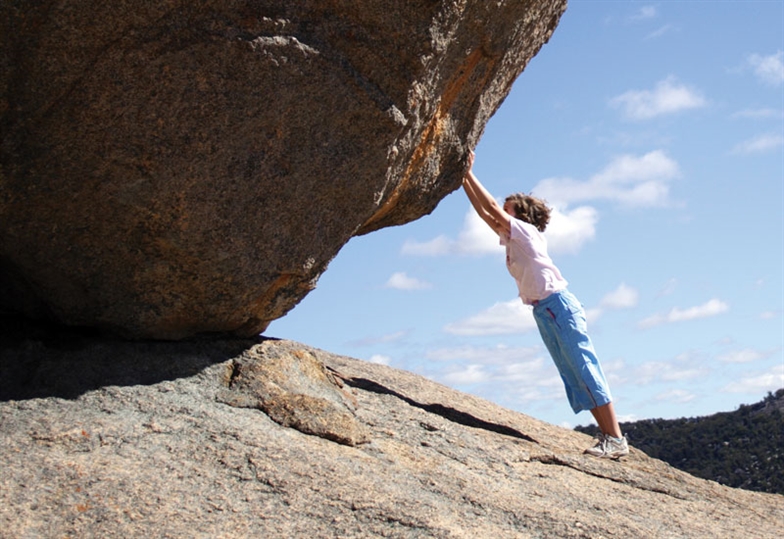When I was young, my mother often asked me, “What are the big rocks in your life?” Before I could answer, she would lovingly pat my back or squeeze my hand and remind me to take my time and answer only after deep reflection and with heartfelt sincerity.
My mother’s question was based on a simple, but powerful story—a story that she first shared with me the summer before I began middle school and repeated throughout my life, a story she now shares with my kids, thoughtfully asking them the same question, “What are the big rocks in your life?”
This is how I remember the story:
A teacher filled a large clear jar with bulky stones. He asked the class if the jar was full, to which they confidently replied, “Yes!” He then asked the students to pay close attention as he added some tiny seashells, a bag of pebbles, a bag of sand, and finally a pitcher
of water.
The class watched as the different items sifted throughout the jar. “Now the jar is full,” he exclaimed.

He asked the students to share aloud what they believed to be the point of this exercise. According to one student, the lesson was that even when a person’s life is full, one could always squeeze in more tasks. Another student said the lesson was that we must be patient and allow problems to settle in our life. As the students shared their perspectives, the teacher listened attentively.
Finally, a student asked the teacher to describe the lesson he learned from this activity and what he thought the class should learn from the packed jar.
Finally, a student asked the teacher to describe the lesson he learned from this activity and what he thought the class should learn from the packed jar.
The teacher explained that if he had not placed the big rocks in the jar first, they would not have fit in the jar later. He made the big rocks the priority. He went on to ask the students to reflect on the big rocks in their life and make sure they are making these rocks a priority.
“What are the big rocks in your life?”
The first time my mom posed the question to me, her words lingered in my mind for days. I chewed on the question in between daily chores and common teenage distractions, including fleeting infatuations and my uncontrollable hair.
A few big rocks in my life were easy to identify: family and friends. Of course, my mom challenged me to think deeper, nudging me to be more specific, “Why? How?” Although such questions sometimes frustrated me—mainly because they required me to engage in critical thinking and asked me to defend my thoughts—they also helped me to see more clearly and better understand the things that I identified as priorities in my life.
Some rocks were hard to identify—rocks that I have spent years scouring for, like a paleontologist in search of missing fossils. For example, a rock that I had all along, but only identified while preparing to become a teacher, is my commitment to addressing the needs of socially marginalized young adolescents. Social justice has been a big rock in my life since young adolescence, but only as an adult was I able to buff and shine it.
“What are the big rocks in your life?”
This simple but profound question helped shape my life’s trajectory and my decision to teach. Today, as a teacher educator, I ask my students to ponder the same question, particularly through an educational lens. And before they begin to answer, I find myself echoing my mother, reminding them to take their time and answer the question after deep reflection and with heartfelt sincerity.
To help my students with the critical reflection process, I ask them to review AMLE’s This We Believe (2010) and then create their own “position papers.” I encourage them to think about the following prompt from a teaching and learning perspective: This I believe…[about education, about middle level education, about middle school, about schooling, about teaching, about learning, about theoretical frameworks, about pedagogy, about young adolescents, about different content areas].
As educators, we must take time to ponder, identify, preserve, and celebrate the big rocks in our lives. We must make sure that even when we feel as though we are drowning in an ocean full of paperwork, lesson planning, meetings, emotional vicissitudes, stress, and exhaustion, we make the time to reexamine our beliefs and hopes and make sure our practices are aligned with our core. Those are some of our big rocks.
Two of the biggest rocks in my education jar are: 1) It is a joy and a privilege to support young adolescent learners and 2) Teaching and learning should be celebrated. As middle level educators, This We Believe is a wonderful place to begin our search for the big rocks to fill our education jars. After all, no matter what pressures or challenges we face as teachers, we must remember (and I say this figuratively and literally) middle level rocks!
Listen to an interview with author Rajni Shankar-Brown
Rajni Shankar-Brown is associate professor of curriculum and instruction in the College of Arts and Sciences at Stetson University, DeLand, Forida. rshankar@stetson.edu

